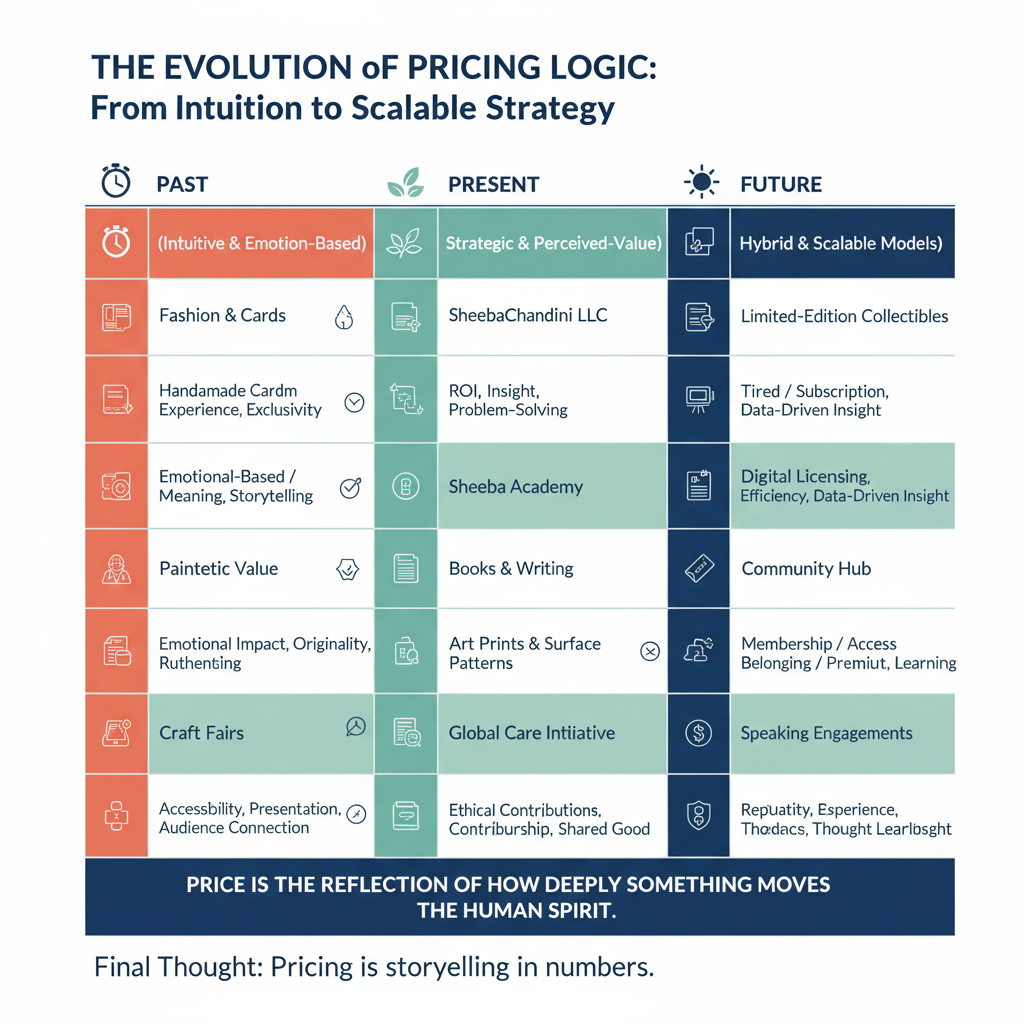The Evolution of Value: How I Learned to Price Meaning
Every creative eventually faces the same quiet question—“What is my work truly worth?”
For me, the answer evolved over decades, shaped by fabrics, paint, paper, pixels, and purpose. I didn’t start by learning to price products; I started by learning to value emotion. This journey from intuitive feeling to strategic architecture is the core of how I approach business today.
From Intuition to Economics: My Early Pricing Lessons
My first brush with pricing came through fashion design—crafting bespoke wedding gowns and costumes. The transaction was never just about the silk and stitching. It was about the transformation. This is where I unknowingly practiced Value-Based Pricing: setting a price that reflected how the design made the client feel and appear, not just the materials or hours spent. When a bride walked taller or a performer shone brighter, the price was justified by the resulting confidence and experience.
Soon after, selling handmade cards at craft fairs became my first study in Emotional Pricing. People weren't buying stationery; they were buying sentiment—the connection between giver and receiver. I learned how human connection itself becomes a form of currency.
When I started selling paintings, I discovered a new rule: beauty cannot be standardized. Two similar canvases could evoke completely different emotions. This taught me the rhythm of Aesthetic Value, where price reflects the buyer’s emotional resonance, not just the labor.
Those early markets and fairs became my first MBA—real-world experiments in consumer psychology and the direct observation of willingness-to-pay.
Pricing in the Present: From Art to Strategy
Today, pricing has evolved into both an art and an architecture designed for maximum impact and scalability.
Design Consulting (SheebaChandini LLC): I now use Impact-Based Pricing, charging for the strategic results clients gain—clarity, growth, and stronger brand identity. We price transformation, not transaction, focusing on measurable ROI.
Education (Sheeba Academy): I shifted to Outcome-Based Pricing. Learners don’t pay for lessons; they pay for what those lessons unlock—the applied success and leadership development.
Creative Assets (Books & Prints): I use a hybrid Content-Based Pricing model. A poem or painting carries weight because of its meaning, merging intellectual property with emotional resonance.
Purpose (Global Care Initiative): Here, I practice Purpose-Based Pricing. The value of the art represents a tangible contribution to humanitarian projects, aligning price directly with ethical impact.
Pricing, I’ve realized, is a mirror of intent.
Future Forward: Designing Value for Scale
As my ecosystem expands, pricing continues to evolve into a symphony of strategy and scalability:
Limited-Edition Collectibles: We will use Prestige Pricing and Scarcity to elevate perceived worth, linking the price to heritage and artistic reputation.
Strategy Tools: Frameworks and dashboards will follow Tiered and Subscription Pricing models, allowing high-value strategic tools to be accessible to audiences from a freelancer to an executive.
Digital Licensing: Design assets will use Usage-Based Pricing, with royalties determined by exclusivity, geography, or time, standard practice in creative IP markets.
Future Labs Research and Advisory: We will use Retainer-Based Pricing, where authority, foresight, and ethical guidance are the premium deliverables sold directly to organizations.
The future of pricing isn’t just about scaling; it’s about synchronizing emotion with economics.
The Philosophy of Pricing
If I were to summarize everything I’ve learned about value, it would sound like this:
“Price is the reflection of how deeply something moves the human spirit.”
When you create from integrity—whether it’s a couture gown, a data dashboard, or a book of poems—the market senses it. True pricing starts with empathy and ends with impact.
My entire journey taught me a different dialect of worth, ultimately shaping one belief that anchors my work: Art and business are not opposites—they are partners in creating meaningful value.
✨ Final Thought: Pricing is storytelling in numbers. It tells the world how much we respect our work and how much we believe in the change it can create.
What part of the pricing journey—Past, Present, or Future—is most relevant to your current business challenge?




